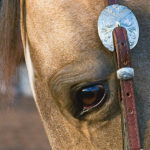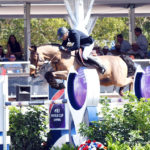Whether you ride the trails or are a serious competitor, good balance and a secure seat will improve your confidence and make you a more effective rider. The opposite of a secure seat is the “chair seat,” a common position flaw where you sit heavily on your bottom, with your legs perched out in front of you. In this position, one quick move by your horse can easily unseat you.
The stirrup-stand exercise I’ll teach you will cure that chair seat, enabling you to use your legs more effectively and adapt to anything your horse might do.
Why this works. Imagine yourself sitting on a 2-foot-tall stool. Your weight is on your bottom, and your legs are propped out in front of you. What would happen if someone walked up and gave you a shove from the front or side? You’d topple right over, wouldn’t you?

Now imagine that you’re sitting on the stool with your legs directly under you and your weight on the balls of your feet as well as on your bottom. Rather than just plopped on the stool, you’re poised over it, balanced and ready. Now if someone were to push you, you’d keep your balance and remain “mounted.”
That same position—with your weight aligned from your head and shoulders down through your hips and deep into your heels—will help you stay equally secure on your horse. The stirrup-stand exercise will get you there.
How to ‘stirrup-stand.’ Start at a standstill, sitting tall in the saddle. If need be, swing your legs back so the fenders of your saddle align directly under your hips (some saddles may need more adjustment than others). Your feet should be directly under your seat (see photo). The old rule of thumb for horsemanship applies here: posture erect, with ear, shoulder, hip, and heel all in alignment. (A watcher from the ground is helpful.)
Next, hold the horn and stand in the stirrups, letting your weight sink even deeper down into your heels (the stirrups will be on the balls of your feet). Bend your knees slightly, keeping your upper body erect and your crotch just out of the saddle.
Now, find your balance point so you can let go of the horn and remain standing—just as if you were standing on the ground.
Don’t lean. If you fall forward, your feet are too far back. If you fall back (more likely), your feet are still too far forward. Don’t make the mistake of compensating by leaning forward and sticking your rear end out (see photo). Instead, realign your legs under you until you can stand in proper form.
‘Absorb’ the motion. When you can manage this exercise easily at a standstill, try it at a walk, gradually moving to a jog and then lope over time. At the faster gaits, your lower body should move with your horse. As your hip, knee, and ankle joints absorb the up-and-down motion of your horse, your upper body will glide along smoothly, comfortably, and securely. At that point, you’ll be actively riding, and not just “chair-sitting.”
Robin Gollehon trains horses and coaches riders, specializing in Western pleasure and yearling longe line. She and her husband, Roger, own and operate Gollehon Quarter Horses in Versailles, Kentucky (gollehon.com). Robin thanks her models, Apryl Kapfhammer and Born To Be Amazing.






